
SALT IN THE FOOD AND AYURVEDA
Share
Whether the dishes are sweet or sour, salt makes the diet complete. Salt gives the right taste to the food and generates interest to consume it.
More importantly, salt aids in our body's digestion and cleansing activities. In Charaka Samhita, the foundational text on Ayurveda, Acharya Charaka alerts about the restriction on the use of salt. He says excessive use of salt causes malaise, laxity, and debility in the body. He says salt affects the stability of ojas, which is the vital energy that nourishes all tissues and is responsible for the optimal functioning of body, mind and spirit.
People who consume excessive salt get low on stamina, as their muscle tone gets destabilised. This brings down their tolerance level to physical or climatic challenges. We notice barren describes the injurious effects of salt and its viable alternatives, lands with saline soil having trees or plants with stunted growth.
Similarly, individuals who consume excessive salt age faster with wrinkles on the skin, greying of hair, and baldness. Excessive use should mean excess quantity of salt in diet, such as salt-based recipes like pickles, and using salt more frequently over every meal daily, across days and seasons.
While common salt added to food is bad for health, there are food resources that have a naturally occurring salt taste in them. An example is a spinach variety, called Wild Purslane (known as pasalai keerai in Tamil).
Such salty food sources are good for cleansing pathways in the body and they improve the appetite. Risks of Overuse According to Ayurveda, rakta (blood) is the prime dhatu impacted by the overuse of salt in the diet. Raktadhatu is responsible for longevity, skin colour, and nourishment of muscle tissues. Salt provokes pitta in association with raktadhatu (which is a seat of pitta dosha). This leads to a cascade of events at the tissues, srotas (channels), and eventually the mind. It can worsen itches and discharges in skin diseases. An increase of blood pressure, loss of potency in the blood vessels, and damage to kidneys are other negative effects of excessive salt usage.
Among the six tastes, salt being an essential diet component, even use of normal quantities can accumulate over a period of time in the body (unnoticed by the consumer) leading to long-term health implications.
The pitta imbalance created by excessive salt affects the mind, attentuating krodha (anger), mental agitation and irritability, all termed as indriya dourbalya, or lack of strength in sense organs. This gives rise to lower will power. Bhagavad Gita, while describing three kinds of food as part of Sraddhatraya Vibhaga Yoga (chapter 17), mentions that salty foods are liked by people dominated by rajasic tendencies. As salty food impairs elevated levels of spirituality in practitioners, yogis and spiritual masters avoid salt, or minimise its usage as their dharma acharana, or following a disciplined life.
A better alternative to common salt, which comprises 40 percent of the chemical soldium, is rock salt, or the Himalayan pink salt, popularly known as saindha namak (saindhava lavana). It is mined naturally, and not processed as common salt.
Rock salt has many positives contrary to common salt. It is highly valued in Ayurveda as it is good for the heart, improves eye health, and balances all three bio-energies or tridosha (vata, pitta and kapha).
Rock salt does not cause heartburn, while aiding in clearing the bowel and in the reduction of chest congestion due to phlegm.
- Harikrishnan Meenakshisundaram
